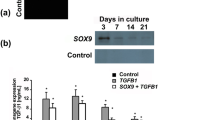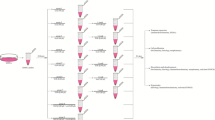Abstract
Objectives
Prolonged in vitro culture of primary articular chondrocytes results in dedifferentiation to a fibroblast-like cell with reduced expression of the Sox9 transcription factor and the extracellular matrix protein collagen II. The ability to genetically-modify chondrocytes to allow both proliferation and maintenance of an articular phenotype may provide increased numbers of appropriate cells for regeneration of large cartilage defects.
Results
Canine chondrocytes were expanded in monolayer culture and transduced with a lentiviral vector expressing Sox9 or in combination with a multicistronic lentiviral vector expressing the four induced pluripotency stem (iPS) cell factors, Oct4, Klf4, Sox2 and c-Myc (OSKM). 3D pellet cultures of transduced cells in the presence of TGFβ-3 revealed increased pellet size and higher levels of total glycosaminoglycan in both Sox9 and Sox9+ OSKM co-transduced chondrocytes compared to untransduced and green fluorescent protein expressing controls. Immunohistochemical detection of Sox9 and collagen II was evident in transduced cells (Sox9, OSKM, or Sox9+ OSKM) with very low levels in untransduced chondrocytes, demonstrating a dedifferentiated state (P < 0.01). The marker for chondrocyte hypertrophy, collagen X was highly expressed in Sox9 transduced chondrocytes but lower in OSKM or Sox9+ OSKM cells (P < 0.05).
Conclusion
A combination of Sox9 and OSKM gene delivery to canine chondrocytes allows continuous proliferation in monolayer culture with a higher expression of col2a1 without an increase in the hypertrophy marker collagen X in 3D pellet cultures.



Similar content being viewed by others
References
Brittberg M, Lindahl A, Nilsson A, Ohlsson C, Isaksson O, Peterson L (1994) Treatment of deep cartilage defects in the knee with autologous chondrocyte transplantation. New Engl J Med 331:889–895
Furumatsu T, Tsuda M, Taniguchi N, Tajima Y, Asahara H (2005) Smad3 induces chondrogenesis through the activation of SOX9 via CREB-binding protein/p300 recruitment. J Biol Chem 280:8343–8350
Guzzo RM, Gibson J, Xu R-H, Lee FY, Drissi H (2013) Efficient differentiation of human iPSC-derived mesenchymal stem cells to chondroprogenitor cells. J Cell Biochem 114:480–490
Guzzo RM, Scanlon V, Sanjay A, Xu R-H, Drissi H (2014) Establishment of human cell type-specific iPS cells with enhanced chondrogenic potential. Stem Cell Rev 10:820–829
Hamanaka S, Yamaguchi T, Kobayashi T, Kato-Itoh M, Yamazaki S, Sato H, Umino A, Wakiyama Y, Arai M, Sanbo M (2011) Generation of germline-competent rat induced pluripotent stem cells. PLoS One 6:e22008
Hiramatsu K, Sasagawa S, Outani H, Nakagawa K, Yoshikawa H, Tsumaki N (2011) Generation of hyaline cartilaginous tissue from mouse adult dermal fibroblast culture by defined factors. J Clin Invest 121:640–657
Honda A, Hirose M, Hatori M, Matoba S, Miyoshi H, Inoue K, Ogura A (2010) Generation of induced pluripotent stem cells in rabbits potential experimental models for human regenerative medicine. J Biol Chem 285:31362–31369
Ikeda T, Kamekura S, Mabuchi A, Kou I, Seki S, Takato T, Nakamura K, Kawaguchi H, Ikegawa S, Chung UI (2004) The combination of SOX5, SOX6, and SOX9 (the SOX trio) provides signals sufficient for induction of permanent cartilage. Arthritis Rheum 50:3561–3573
Im GI, Lee JM, Kim HJ (2011) Wnt inhibitors enhance chondrogenesis of human mesenchymal stem cells in a long-term pellet culture. Biotechnol Lett 33:1061–1068
Khodadadi K, Sumer H, Pashaiasl M, Lim S, Williamson M, Verma PJ (2012) Induction of pluripotency in adult equine fibroblasts without c-MYC. Stem Cells Int. doi:10.1155/2012/429160
Kim JH, Kim K, Youn BU, Lee J, Kim I, Shin HI, Akiyama H, Choi Y, Kim N (2014) Kruppel-like factor 4 attenuates osteoblast formation, function and cross talk with osteoclasts. J Cell Biol 204:1063–1074
Kingston RE, Chen CA, Okayama H (2001) Calcium phosphate transfection. Curr Protoc Neurosci. doi:10.1002/0471142301.nsa01cs01
Li HX, Han M, Bernier M, Zheng B, Sun SG, Su M, Zhang R, Fu JR, Wen JK (2010) Krüppel-like factor 4 promotes differentiation by transforming growth factor-β receptor-mediated Smad and p38 MAPK signaling in vascular smooth muscle cells. J Biol Chem 285:17846–17856
Li Y, Tew SR, Russell AM, Gonzalez KR, Hardingham TE, Hawkins RE (2004) Transduction of passaged human articular chondrocytes with adenoviral, retroviral, and lentiviral vectors and the effects of enhanced expression of SOX9. Tissue Eng 10:575–584
Lin Z, Fitzgerald JB, Xu J, Willers C, Wood D, Grodzinsky AJ, Zheng MH (2008) Gene expression profiles of human chondrocytes during passaged monolayer cultivation. J Orthop Res 26:1230–1237
Liu TM, Wu YN, Guo XM, Hui JH, Lee EH, Lim B (2009) Effects of ectopic Nanog and Oct4 overexpression on mesenchymal stem cells. Stem Cell Dev 18:1013–1022
Logan AC, Nightingale SJ, Haas DL, Cho GJ, Pepper KA, Kohn DB (2004) Factors influencing the titer and infectivity of lentiviral vectors. Hum Gene Ther 15:976–988
Ma B, Leijten JC, Wu L, Kip M, van Blitterswijk CA, Post JN, Karperien M (2013) Gene expression profiling of dedifferentiated human articular chondrocytes in monolayer culture. Osteoarthr Cartil 21:599–603
Montserrat N, Bahima EG, Batlle L, Häfner S, Rodrigues AM, González F, Belmonte JC (2011) Generation of pig iPS cells: a model for cell therapy. J Cardiovasc Transl Res 4:121–130
Motoyama J, Eto K (1994) Antisense c-myc oligonucleotide promotes chondrogenesis and enhances RA responsiveness of mouse limb mesenchymal cells in vitro. FEBS Lett 338:323–325
Nagy K, Sung HK, Zhang P, Laflamme S, Vincent P, Agha-Mohammadi S, Woltjen K, Monetti C, Michael IP, Smith LC, Nagy A (2011) Induced pluripotent stem cell lines derived from equine fibroblasts. Stem Cell Rev Rep 7:693–702
Nie Z, Hu G, Wei G, Cui K, Yamane A, Resch W, Wang R, Green DR, Tessarollo L, Casellas R, Zhao K, Levens D (2012) c-Myc is a universal amplifier of expressed genes in lymphocytes and embryonic stem cells. Cell 151:68–79
Outani H, Okada M, Hiramatsu K, Yoshikawa H, Tsumaki N (2011) Induction of chondrogenic cells from dermal fibroblast culture by defined factors does not involve a pluripotent state. Biochem Biophys Res Commun 411:607–612
Outani H, Okada M, Yamashita A, Nakagawa K, Yoshikawa H, Tsumaki N (2013) Direct induction of chondrogenic cells from human dermal fibroblast culture by defined factors. PLoS One 8:e77365
Park SB, Seo KW, So AY, Seo MS, Yu KR, Kang SK, Kang KS (2012) SOX2 has a crucial role in the lineage determination and proliferation of mesenchymal stem cells through Dickkopf-1 and c-MYC. Cell Death Differ 19:534–545
Rahl PB, Lin CY, Seila AC, Flynn RA, McCuine S, Burge CB, Sharp PA, Young RA (2010) c-Myc regulates transcriptional pause release. Cell 141:432–445
Ruan W, Han J, Li P, Cao S, An Y, Lim B, Li N (2011) A novel strategy to derive iPS cells from porcine fibroblasts. Sci China Life Sci 54:553–559
Stokes DG, Liu G, Dharmavaram R, Hawkins D, Piera-Velazquez S, Jimenez SA (2001) Regulation of type-II collagen gene expression during human chondrocyte de-differentiation and recovery of chondrocyte-specific phenotype in culture involves Sry-type high-mobility-group box (SOX) transcription factors. Biochem J 360:461–470
Sumer H, Liu J, Malaver-Ortega LF, Lim ML, Khodadadi K, Verma PJ (2011) NANOG is a key factor for induction of pluripotency in bovine adult fibroblasts. J Anim Sci 89:2708–2716
Takahashi K, Tanabe K, Ohnuki M, Narita M, Ichisaka T, Tomoda K, Yamanaka S (2007) Induction of pluripotent stem cells from adult human fibroblasts by defined factors. Cell 131:861–872
Takahashi K, Yamanaka S (2006) Induction of pluripotent stem cells from mouse embryonic and adult fibroblast cultures by defined factors. Cell 126:663–676
Tew SR, Li Y, Pothacharoen P, Tweats LM, Hawkins RE, Hardingham TE (2005) Retroviral transduction with SOX9 enhances re-expression of the chondrocyte phenotype in passaged osteoarthritic human articular chondrocytes. Osteoarthr Cartil 13:80–89
Tsuchiya H, Kitoh H, Sugiura F, Ishiguro N (2003) Chondrogenesis enhanced by overexpression of sox9 gene in mouse bone marrow-derived mesenchymal stem cells. Biochem Biophys Res Commun 301:338–343
Acknowledgements
This work was supported by Charles Sturt University Faculty of Science (COMPACT) Post-Graduate Scholarship Award.
Author information
Authors and Affiliations
Corresponding author
Rights and permissions
About this article
Cite this article
Gurusinghe, S., Young, P., Michelsen, J. et al. Suppression of dedifferentiation and hypertrophy in canine chondrocytes through lentiviral vector expression of Sox9 and induced pluripotency stem cell factors. Biotechnol Lett 37, 1495–1504 (2015). https://doi.org/10.1007/s10529-015-1805-5
Received:
Accepted:
Published:
Issue Date:
DOI: https://doi.org/10.1007/s10529-015-1805-5




